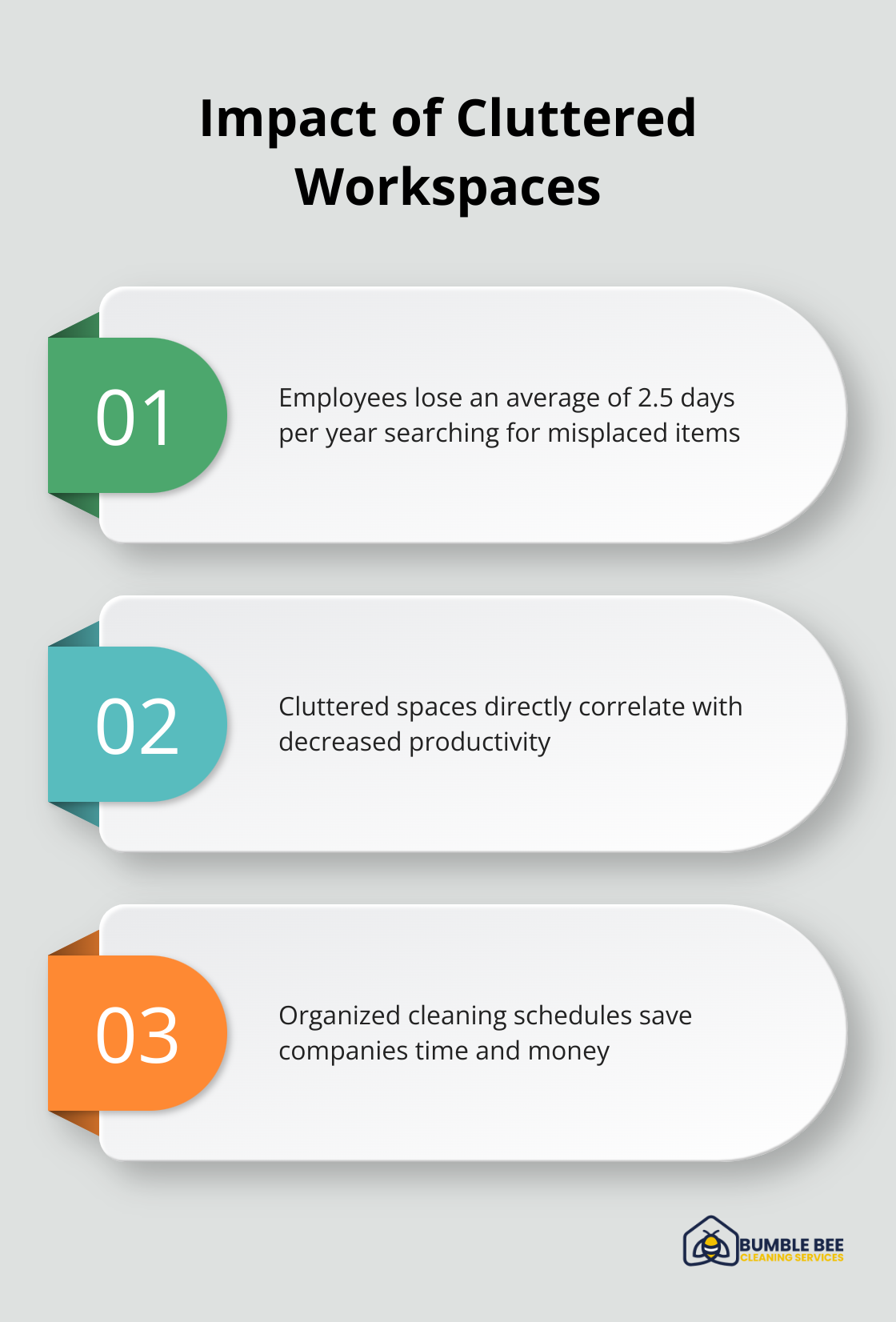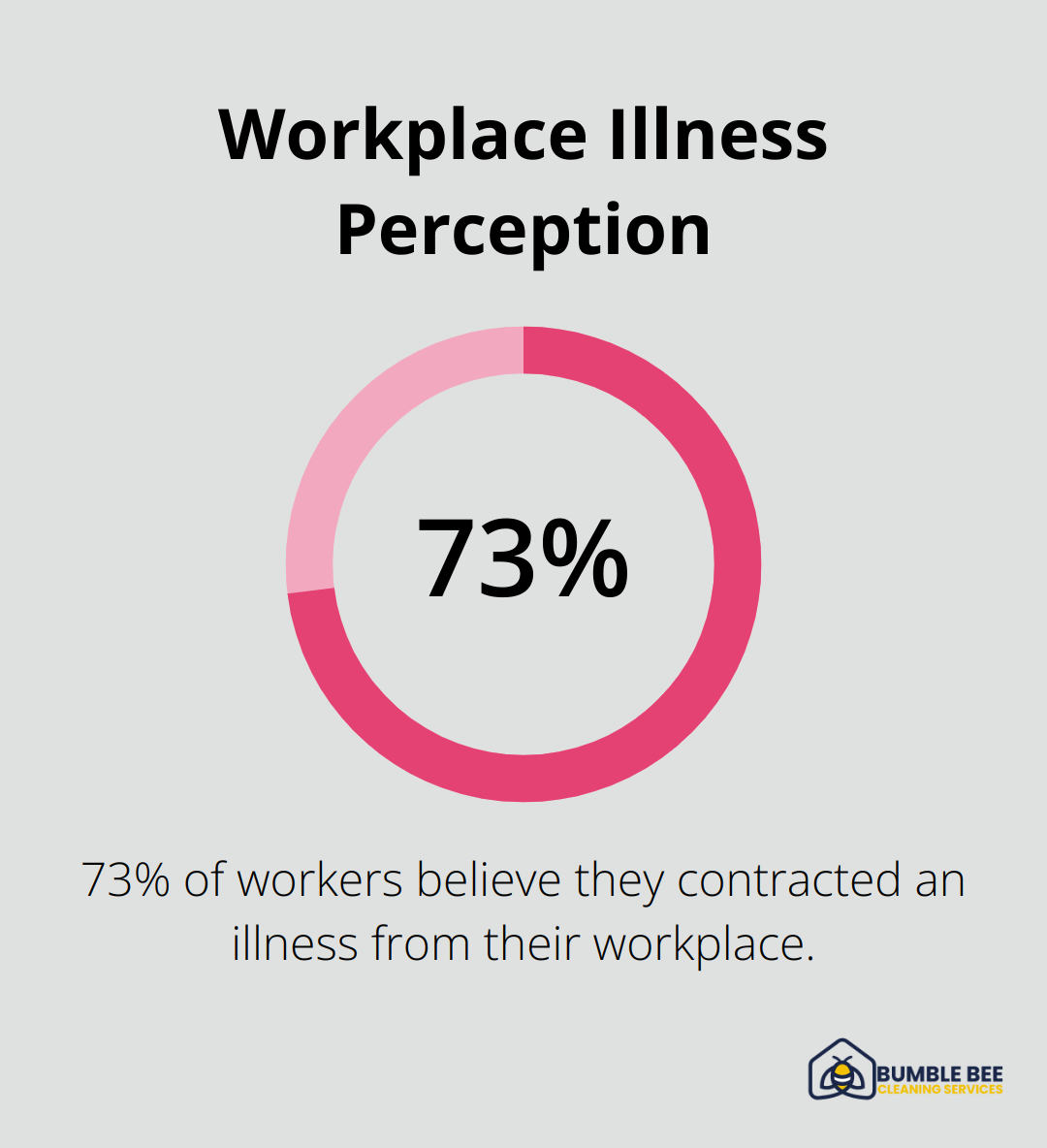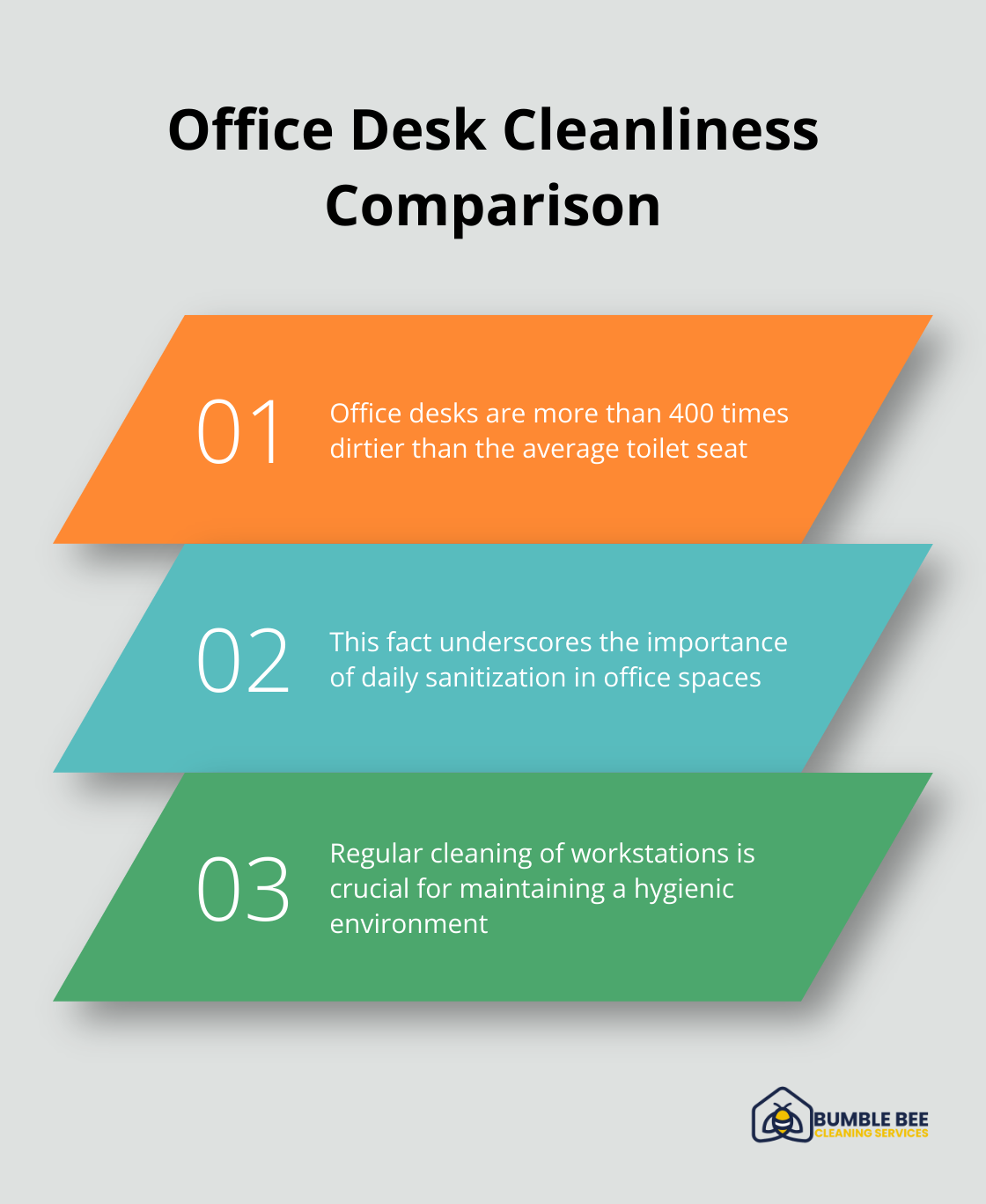A well-structured office cleaning schedule is the backbone of a productive and healthy workplace. At Bumble Bee Cleaning Services, we’ve seen firsthand how proper janitorial scheduling can transform an office environment.
From boosting employee morale to creating a stellar first impression for clients, a comprehensive cleaning plan tackles it all. In this post, we’ll share expert tips to help you master your office cleaning schedule and reap the benefits of a spotless workspace.
Why a Well-Structured Office Cleaning Schedule Matters
The Power of a Clean Workspace
A well-structured office cleaning schedule transforms more than just the physical environment. It acts as a catalyst for improved business performance and employee well-being. At Bumble Bee Cleaning Services, we understand the profound impact a comprehensive cleaning plan can have on various aspects of your organization.
Productivity Soars in Clean Environments
A tidy office directly correlates with increased productivity. HLW International LLP’s research reveals that employees lose an average of 2.5 days per year searching for misplaced items in cluttered spaces. An organized cleaning schedule doesn’t just tidy up; it actively saves your company time and money (which can add up to significant amounts over a year).

Health Benefits and Reduced Absenteeism
The cleanliness of an office significantly affects employee health. The National Center for Biotechnology Information states that proper cleaning and disinfection can cut virus spread by up to 80%. This reduction translates to fewer sick days and increased productivity. A Staples study found that 73% of workers believe they contracted an illness from their workplace. A rigorous cleaning schedule serves as an investment in your team’s health and your company’s overall productivity.

Impressing Clients and Visitors
First impressions carry substantial weight in the business world. A well-maintained environment reflects professionalism and influences client perceptions, potentially impacting business success significantly. This highlights the importance of maintaining a spotless environment, especially in areas where clients interact.
The Strategic Advantage of Cleanliness
Implementing a well-structured office cleaning schedule extends beyond mere aesthetics. It represents a strategic business decision that positively impacts productivity, health, and client perception. As we move forward, we will explore the key components that constitute an effective cleaning schedule, equipping you with the necessary tools to create an immaculate and efficient workplace.
What Makes an Effective Office Cleaning Schedule?
An effective office cleaning schedule serves as the foundation for a hygienic and productive workplace. The key components of a successful cleaning plan maximize cleanliness while minimizing disruption. Let’s explore these essential elements that contribute to an efficient cleaning schedule.
Frequency: The Cornerstone of Cleanliness
The frequency of cleaning tasks plays a vital role in maintaining a pristine office environment. Daily tasks form the basis of a clean office. These include:
- Emptying trash bins
- Wiping down high-touch surfaces (doorknobs, light switches)
- Vacuuming high-traffic areas
A study revealed that office desks are more than 400 times dirtier than a toilet seat, underscoring the importance of daily sanitization.

Weekly tasks build upon this foundation. These typically involve:
- Thorough floor cleaning
- Comprehensive dusting of all surfaces
- Sanitizing communal areas (break rooms, conference rooms)
The Centers for Disease Control and Prevention (CDC) recommends weekly disinfection of shared spaces to prevent illness spread.
Monthly tasks complete the schedule with deep cleaning activities such as:
- Steam cleaning carpets
- Washing windows
- Cleaning air vents
The Environmental Protection Agency (EPA) suggests that the most effective way to improve indoor air quality is to eliminate individual sources of pollution or to reduce their emissions.
Customization: Tailoring to Your Unique Space
Every office has its own characteristics, and your cleaning schedule should reflect this uniqueness. High-traffic areas like reception desks may require attention multiple times a day, while less-used storage rooms might only need weekly cleaning.
A study by the International Facility Management Association found that customized cleaning schedules can reduce cleaning costs by up to 30% while maintaining high standards of cleanliness.
Strategic Timing: Minimizing Disruptions
The timing of cleaning tasks can significantly impact office productivity. Early morning or evening cleaning sessions minimize disruptions to the workday. A survey by OfficeTeam revealed that 54% of employees find it distracting when cleaning occurs during work hours.
Try to schedule more intensive cleaning tasks for weekends or after hours to ensure a seamless work environment.
Adaptability: Embracing Change
An effective cleaning schedule must remain flexible to accommodate unexpected messes, seasonal changes, or shifts in office usage. Regular reviews and adjustments ensure that your cleaning schedule remains effective as your office evolves.
The International Sanitary Supply Association recommends quarterly reviews of cleaning schedules to maintain optimal efficiency.
As we move forward, we’ll explore how to customize your cleaning schedule for different office areas, ensuring that every corner of your workspace receives the attention it deserves.
Tailoring Your Cleaning Schedule to Office Zones
High-Traffic Areas: Your Office’s First Impression
Reception areas and waiting rooms represent the face of your business. These spaces require frequent attention to maintain a positive first impression. Within seven seconds of meeting, people will have a solid impression of who you are. This fact underscores the critical need for impeccable cleanliness in these areas.
You should schedule cleaning for these zones at least three times daily. Focus on dusting surfaces, sanitizing door handles, and vacuuming carpets. For hard floors, use microfiber mops, which the Environmental Protection Agency reports can reduce bacteria by 99% compared to conventional mops.
Workstations: The Hub of Productivity
Employee desks and cubicles act as hotspots for germs. Research by University of Arizona researchers found that the average desktop has 400 times more bacteria than the average toilet seat (a startling fact that emphasizes the need for regular sanitization of these areas).
Implement a daily quick-clean routine for workstations, focusing on high-touch surfaces like keyboards, mice, and phone handsets. Provide sanitizing wipes for easy access to encourage employee participation. Schedule a more thorough cleaning, including dusting and vacuuming, on a weekly basis.
Break Rooms and Kitchens: Hygiene Hotspots
These communal areas need daily attention to prevent food-related hygiene issues. The Food and Drug Administration reports that harmful bacteria can multiply to dangerous levels on kitchen surfaces in just two hours.
Establish a strict daily cleaning regimen for these spaces. This should include wiping down all surfaces, cleaning microwaves and refrigerators, and sanitizing sinks and faucets. Empty and sanitize trash bins daily to prevent odors and pest attraction.
A clean break room impacts more than just hygiene-it affects employee satisfaction. A survey by Tork revealed that 89% of employees believe that a clean breakroom improves their workplace satisfaction.
Restrooms: Sanitation Central
Office restrooms require multiple daily cleanings to ensure proper sanitation. The Centers for Disease Control and Prevention (CDC) recommends cleaning and disinfecting these areas at least once daily, with more frequent cleaning for high-traffic restrooms.
Focus on sanitizing all surfaces, including toilets, sinks, and door handles. Use EPA-registered disinfectants for effective germ elimination. Don’t forget to regularly check and refill soap dispensers, paper towels, and toilet paper to maintain a fully functional restroom.
Conference Rooms: Meeting Cleanliness Standards
Conference rooms, while not used as frequently as other areas, still need regular attention. These spaces often host important meetings and can influence client perceptions.
Schedule a thorough cleaning after each use, including wiping down tables, chairs, and any technology equipment. Vacuum carpets and empty trash bins daily. Pay special attention to whiteboards or glass surfaces, ensuring they’re spotless for the next meeting.
Final Thoughts
A well-organized office cleaning schedule forms the foundation of a thriving workplace. It increases productivity, improves employee health, and influences client perceptions positively. Effective janitorial scheduling requires a balance of tasks tailored to different office zones, with high-traffic areas demanding frequent attention.
Flexibility plays a key role in maintaining an effective cleaning plan. Regular reviews allow you to adapt to changing office dynamics, seasonal variations, and unexpected situations. Many businesses find that partnering with professional cleaning services yields optimal results.
At Bumble Bee Cleaning Services, we understand the intricacies of maintaining a spotless office environment. Our team can create a customized cleaning plan that addresses your specific needs (ensuring a pristine workspace that promotes productivity, health, and professionalism). Take the first step towards a cleaner, more productive workplace today.
